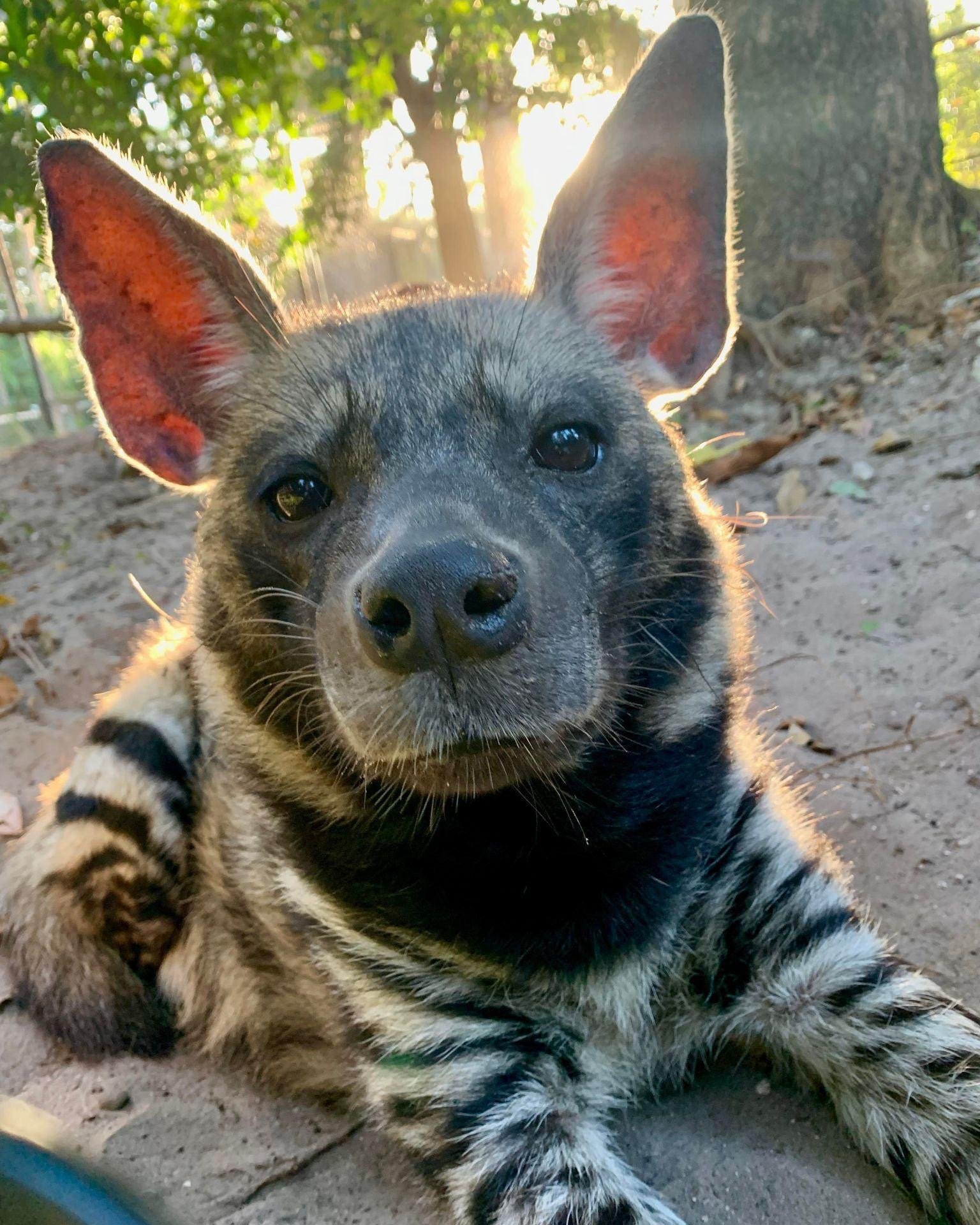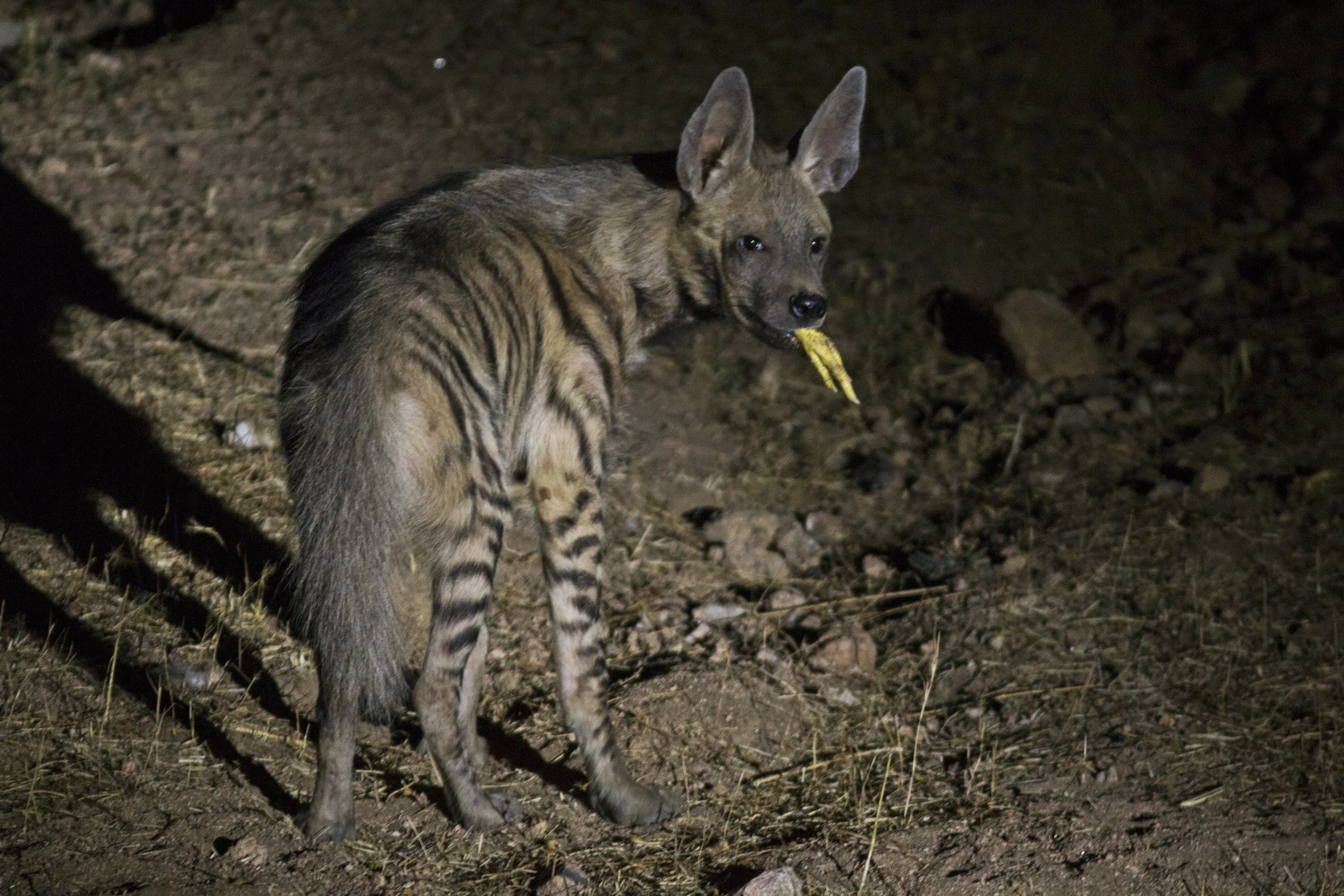Floof Life







Dear Gentle Reader, I know that people think all hyenas are the laughing evil henchmen of the Lion King, but that’s not quite the case. There are 4 species of hyena and they are all wonderful, vital to the health of the ecosystem, and very misunderstood. I will be giving each species there own post, because they are so different from each other, a play different roles. This week I want to highlight one of the species that inspired the blog, and is a decal on my car (along with the catch phrase Floof Life)… I am very excited to introduce the elusive Striped Hyena. Lets dig into it!
What is it? These wonderful animals are members of the hyena family, and is the second smallest species of hyena (they aren’t that small). Within the Carnivore order, there are two sub orders: Feliformia (cat-shaped) and Caniformia (dog shaped). Despite looking like they would related to the canine side of the family tree, hyenas are more closely related to cats… I know, weird. Like the name suggests, these hyenas sport spiffy stripes and an impressive mane along the back of their neck that I like to call the “floof” (now floof life makes sense). Striped hyenas are rather stocky, have thick necks, short brushy tail, and the cutest pointed ears you will ever see. They can grow to just over 2 feet at the shoulder and weigh around 49 to 121 pounds (the average is ~77lbs). They live around 13 years in the wild, but in zoological settings they can live up to or past 20 years (they have better healthcare than I do). Lastly, many people know that female hyenas have physical attributes that resemble males, but that is only partially true for the striped hyenas. So yes ladies do have small psuedopenis structures, but not nearly as prominent as the spotted hyenas (we will get to that on their post). The ladies also run the show, like elephants, hyenas have a matriarchal social structure. Woo, ladies!!
Where are these hyenas found? These hyenas span much of the classical ancient world. Striped hyenas are found across East and North Africa, across the Arabian peninsula into central Asia, and down into the depths of India. They are found in isolated populations across arid to semi-arid bushland, forests, and even wetlands. Some striped hyenas have been known to reside in urban areas, scavenging from human trash. They are known to have dens that range from caves, crevices, and burrows that they dug themselves or borrowed from other species. Usually, striped hyenas are solitary, with few exceptions, and can be found in home ranges that can overlap another’s territory.
What do striped hyenas eat? Striped hyenas are on the shy side, and are primary scavengers. Their diet consists of mostly of hoofstock carcasses, other carrion except vultures (I don’t know why), fruit and some vegetation, bones, grasshoppers, garbage, and in some instances small animals they can overpower. One of the largest issues people of these animals is that, because they are scavengers, striped hyenas have been known to scavenge graves. So there is a custom in some places to pile rocks on top of graves to keep hyenas out. In summation, they are the vacuum cleaners/garbage disposal of their habitat.
What does striped hyena dating look like? Similar to the last post, striped hyenas can form monogamous pairs. It’s adorable. The couple will find a den site together and establish a home territory. In the wild, striped hyena mating season varies depending on where it lives, and in zoological settings they can mate year-round. Females can give birth to 1 to 6 cubs after a 90 day gestation. Both parents, and occasionally older siblings, help raise the cubs. They are a tight knit family, and the cubs will stay with their doting parents for a year. They are an ideal couple, we should all take notes.
What are the striped hyena superpowers? To be the absolute cutest little things on the planet. Ok for real, striped hyenas are the smallest of the “bone crushing” hyenas, meaning they are able to break bones with their exceptionally strong jaws, eat and digest bones. This may not seem like a super power, but it’s an important function of a healthy ecosystem. Then when they poop, the bones are broken down enough that other species benefit from the calcium rich….hyena nuggets. A second superpower of theirs is that they keep the spread of disease. By eating carcasses, striped hyenas stop the spread of diseases like anthrax and tuberculosis. Saving the world one meal at a time. Lastly, I have to bring up something that is powerful but icky, and I may have been on the receiving of it (I don’t want to talk about it). So, hyenas use scent marking to designate their territory. Most animals tinkle/spray, but not our striped hyena, they go above and beyond. Striped hyenas create this truly awful, cursed, beyond foul substance nicknamed Hyena Butter. This stinky substance is produced in the hyena…booty, and really does look like soft butter. This hyena butter is so super that if you get even the tiniest amount on you, you will stink to high heaven for the rest of the day and possibly life. It’s super. My hyena butter PTSD is flaring up, we need to move on.
How many are there? Despite how wide spread the species is, they are isolated and fragmented. In some parts of their home range, striped hyenas have disappeared completely. The current estimate is around 5,000 to 10,000 mature adults. This is an estimate due to striped hyenas being nocturnal, solitary, and low densities spread across difficult terrain. There are no subspecies, but there are color variations depending where the hyenas live. Once again, they are adorable not matter what color they are.
This Hera, the most beautiful striped hyena in all the land. She really enjoyed this coconut enrichment. Enjoy her being goofy.
Wooo, Science Time!!
Striped hyena - Hyaena hyaena (they’re so hyena, you have to say it twice)
According to the IUCN Red List striped hyenas are listed Nearly Threatened. Their main threats are persecution (mostly through poison, which also kills vultures, but we will get into that later), declining numbers of other large carnivores, and loss of habitat.
People indicated a strong loathing for striped hyenas because of superstition, folklore, and their connection to grave robbing. I bring this up because I wanted to show you a super brief glimpse of what I’m writing my grant proposal about. I’m looking into how folklore/stories shape our perception of species. I am hoping to spend time in Africa recording stories and looking at hyena populations. So, yep, that’s all I have for now.
Resources:
AbiSaid, M. & Dloniak, S.M.D. 2015. Hyaena hyaena. The IUCN Red List of Threatened Species 2015: e.T10274A45195080. https://dx.doi.org/10.2305/IUCN.UK.2015-2.RLTS.T10274A45195080.en.
San Diego Zoo Wildlife Alliance (n.d.). Striped Hyena Hyaena hyaena. Animals and Plants. https://animals.sandiegozoo.org/animals/striped-hyena
Utica Zoo. (2022). Striped Hyena. Animals. https://www.uticazoo.org/stripedhyena

